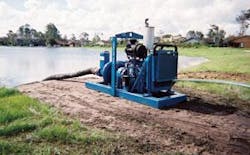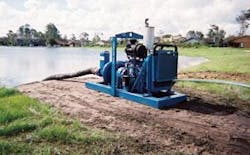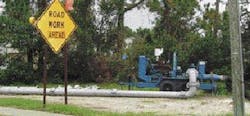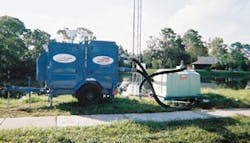Three Examples:Rising Needs for Stormwater Management Systems
By George Olsker
Cities nationwide find stormwater relief with temporary and permanent pumping systems to combat flooding, erosion and water quality degradation. These modern industrial systems are larger, stronger and faster than ones previously utilized and provide a substantial return on investment according to public works officials.
Permanent Backup Systems
When hurricanes hit land, thousands of residents lose power, communication, water and wastewater services. The loss of these necessities make residents understand the importance of public utility systems and the emergency backup systems that keep them operational after a disaster. After Hurricane Opal struck the Florida Panhandle in 1995, Regional Utilities Inc. experienced lightning strikes and damage to generator control panels preventing backup generators from operating. The utility provider for several hundred thousand residents in the Gulf Coast area thought it best to install permanent lift station backup systems to the Florida communities it served. These pumps needed to not only provide uninterrupted service, but automatically start after a shutdown or failure takes place. Thompson Pump installed 10 self-priming, solids-handling pumps with dry-priming systems and automatic start/stop capabilities to master lift stations. The automatic start/stop systems operated with floats that turned on the pumps when fluid levels rose and turned them off when the levels fell. These pumps also are used during occasional lift station repairs. The systems were put to the test in September 2004 when hurricanes’ Ivan and Jeanne hit the area. While other municipalities along the Florida coast lost lift station operation, Regional Utilities was pumping efficiently.
Updating Storm Drains
Preparing for Heavy Rains
The Interstate 4 corridor running east and west through Central Florida is a congested traffic zone that experiences heavy summer rainfall causing additional danger. Eby Construction installed 35,000 feet of new sewer and stormwater pipe and excavated 27 ponds to better accommodate the heavy rains. Thompson Pump provided its vacuum Wellpoint pumps for the wellpoint dewatering. These pumps can handle high flows, achieve and maintain prime on their own and provide high air-handling capability. Thompson’s double diaphragm pumps were also used for the general dewatering applications. With a 100-gallon integral fuel tank, these models pump consistently for more than 24-hours on a single tank of gas and can run dry indefinitely. The pumping systems provided a quick solution to the dewatering problems and allowed for better stormwater prevention in Central Florida’s busiest tourist sector. IWW
About the Author: George Olsker is the national accounts manager at Thompson Pump & Manufacturing Co. Inc., based in Port Orange, Fla. The company also provided 30 heavy-duty pumps to help dewater New Orleans in flooding following Hurricane Katrina in August 2005. Contact: 800-767-7310 or www.thompsonpump.com.




